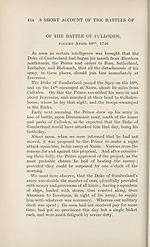Series 2 > Origins of the 'Forty-five
(512) Page 415
Download files
Complete book:
Individual page:
Thumbnail gallery: Grid view | List view

PRESTON, FALKIRK, AND CULLODEN 415
In this situation the Prince could not propose to keep
his army together. He was obliged either to fight or
starve. And altho above 3000 men, under the command
of the Earl of Cromarty, Macdonald of Barisdale, Mac-
gregor of Glengyle, Cluny Macpherson, and others, who
were expected every hour, had not yet joined, he resolved
to risk the event of an engagement.
The night attack being therefore agreed to, was to have
been executed thus. One third of the army, commanded
by Lord George Murray, were to have passed the water
of Nairn, two miles below Culraick, and two from Nairn,
to have attacked the enemy on the south east near to the
sea ; whilst the other two thirds, under the command of
the Duke of Perth and his brother Lord John Drummond,
were to have attacked them on the plain, from the north
east and all the way to the sea, so as to have joined those
who were to have attacked on the other side.
That our design might not be discovered by the enemy,
the, march began about eight o’clock at night. Lord
George Murray led the van. He had along with him,
besides several gentlemen volunteers and officers, 30 men
of the Mackintoshes, who lived in that very country, as
guides. They conducted him the moor road, that he
might not fall in with the enemy’s patrolls ; and small
parties were stationed at proper distances to prevent the
enemy from receiving any intelligence.
As the highlanders had often marched more than two
miles in an hour, it was hoped that they could have reached
Nairn before two o’clock. But before Lord George had
marched a mile, he received a message that the half of the
line was at a considerable distance, and orders to halt, or
march slower, till the line should join. He received many
messages by aides-de-camps and other officers, sent for
the same purpose, Ipy the time he had reached six miles.
Altho he did not halt, he marched always slower, hoping
that would do : For he knew that a halt in the van
occasions a greater one in the rear, when the march begins
again ; whereas by marching slow, the rear might have
joined without that inconveniency.
In this situation the Prince could not propose to keep
his army together. He was obliged either to fight or
starve. And altho above 3000 men, under the command
of the Earl of Cromarty, Macdonald of Barisdale, Mac-
gregor of Glengyle, Cluny Macpherson, and others, who
were expected every hour, had not yet joined, he resolved
to risk the event of an engagement.
The night attack being therefore agreed to, was to have
been executed thus. One third of the army, commanded
by Lord George Murray, were to have passed the water
of Nairn, two miles below Culraick, and two from Nairn,
to have attacked the enemy on the south east near to the
sea ; whilst the other two thirds, under the command of
the Duke of Perth and his brother Lord John Drummond,
were to have attacked them on the plain, from the north
east and all the way to the sea, so as to have joined those
who were to have attacked on the other side.
That our design might not be discovered by the enemy,
the, march began about eight o’clock at night. Lord
George Murray led the van. He had along with him,
besides several gentlemen volunteers and officers, 30 men
of the Mackintoshes, who lived in that very country, as
guides. They conducted him the moor road, that he
might not fall in with the enemy’s patrolls ; and small
parties were stationed at proper distances to prevent the
enemy from receiving any intelligence.
As the highlanders had often marched more than two
miles in an hour, it was hoped that they could have reached
Nairn before two o’clock. But before Lord George had
marched a mile, he received a message that the half of the
line was at a considerable distance, and orders to halt, or
march slower, till the line should join. He received many
messages by aides-de-camps and other officers, sent for
the same purpose, Ipy the time he had reached six miles.
Altho he did not halt, he marched always slower, hoping
that would do : For he knew that a halt in the van
occasions a greater one in the rear, when the march begins
again ; whereas by marching slow, the rear might have
joined without that inconveniency.
Set display mode to:
![]() Universal Viewer |
Universal Viewer | ![]() Mirador |
Large image | Transcription
Mirador |
Large image | Transcription
Images and transcriptions on this page, including medium image downloads, may be used under the Creative Commons Attribution 4.0 International Licence unless otherwise stated. ![]()
| Scottish History Society volumes > Series 2 > Origins of the 'Forty-five > (512) Page 415 |
|---|
| Permanent URL | https://digital.nls.uk/126865335 |
|---|
| Attribution and copyright: |
|
|---|
| Description | Over 180 volumes, published by the Scottish History Society, containing original sources on Scotland's history and people. With a wide range of subjects, the books collectively cover all periods from the 12th to 20th centuries, and reflect changing trends in Scottish history. Sources are accompanied by scholarly interpretation, references and bibliographies. Volumes are usually published annually, and more digitised volumes will be added as they become available. |
|---|


